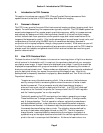Section 1 - Introduction
Page 1
1. Introduction
Congratulations and thank you for buying one of Santa Barbara Instrument Group's CCD
cameras. The model ST-7E, ST-8E and ST-9E are SBIG's fourth generation CCD cameras and
represent the state of the art in CCD camera systems with their low noise and advanced
capabilities, including Kodak's new Blue Enhanced E series of CCDs. We feel that these
cameras will expand your astronomy experience by being able to easily take images like the
ones you've seen in books and magazines, of structure never seen through the eyepiece. SBIG
CCD cameras offer convenience, high sensitivity, and advanced image processing techniques
that film just can't match. While CCDs will probably never replace film in its large format,
CCDs allow a wide range of scientific measurements and have established a whole new field of
amateur astronomy that is growing by leaps and bounds.
The ST-7E, ST-8E and ST-9E cameras include an exciting new feature: self-
guiding (US Patent 5,525,793). These cameras have two CCDs inside; one for guiding and a
large one for imaging. The low noise of the read out electronics virtually guarantees that a
usable guide star will be within the field of the guiding CCD for telescopes with F/numbers
F/6.3 or faster. The relay output plugs directly into most recent commercial telescope drives.
As a result, you can take hour long guided exposures with ease, with no differential deflection
of guide scope relative to main telescope, and no radial guider setup hassles, all from the
computer keyboard. This capability, coupled with the phenomenal sensitivity of the CCD, will
allow the user to acquire observatory class images of deep sky images with modest apertures!
The technology also makes image stabilization possible through our AO-7, or self-guided
spectroscopy with our SGS.
1.1. Road Map of the Documentation
This manual describes the ST-7E, ST-8E and ST-9E CCD Camera Systems from Santa Barbara
Instrument Group. For users new to the field of CCD Astronomy, Sections 2, 3 and 4 offer
introductory material about CCD Cameras and their applications in Astronomy. Users who are
familiar with CCD cameras may wish to skip section 2 and browse through sections 3 and 4,
reading any new material.
Thoroughly experienced SBIG customers may wish to jump right to the separate
Software Manual, which gives detailed and specific information about the SBIG software.
Sections 5 and 6 offer hints and information about advanced imaging techniques and
accessories for CCD imaging that you may wish to read after your initial telescope use of the
CCD camera. Finally, section 7 may be helpful if you experience problems with your camera,
and the Appendices provide a wealth of technical information about these systems.
1.2. Quick Tour
This section is a quick guided tour of the CCD Camera System you have just purchased. If
you're like most people you want to get started right away and dispense with the manual. Use
this section as a guide for learning about your new system.


















